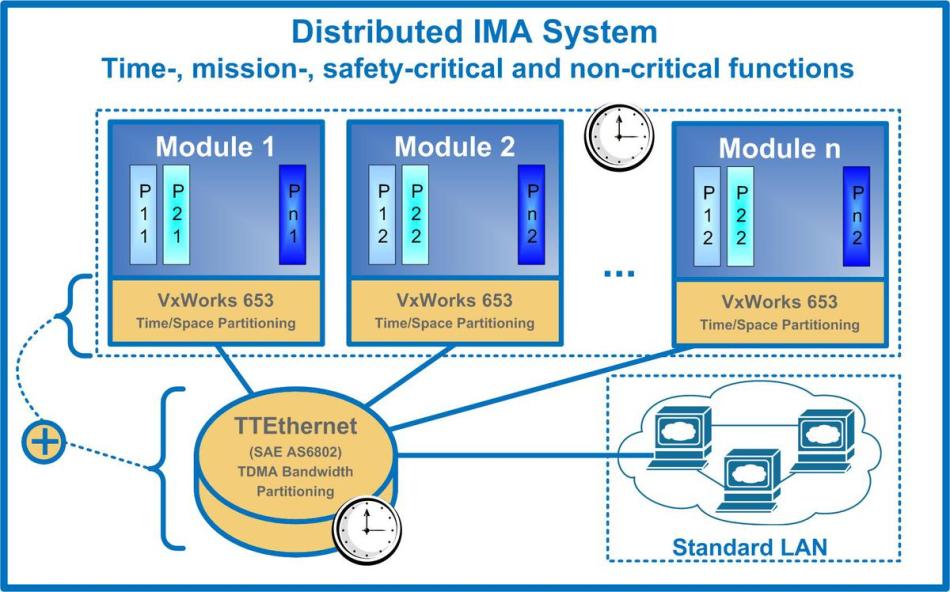June 14, 2010
TTTech, the leading supplier of dependable networking solutions based on time-triggered technology, has delivered a Distributed Integrated Modular Avionics (IMA) test bed to Sikorsky Aircraft Corporation, a subsidiary of United Technologies Corp. (NYSE:UTX). Distributed IMA is a class of integrated architectures which inherits all benefits of Integrated Modular Avionics based upon the ARINC 653 avionics standard, and enables the efficient design of distributed systems with mixed criticality applications. Distributed IMA architectures eliminate the traditional conflict of criticality vs. flexibility, and close the gap between federated IMA and networked architectures. Distributed IMA based on the TTEthernet protocol can significantly control system complexity while facilitating designs of advanced and reliable electronic systems with lower life cycle costs.

Sikorsky Aircraft is working on a proof-of-concept for the new generation of modular, reusable, and scalable integrated Vehicle Management System (VMS). In contrast to existing IMA systems, hard real-time control loops and isochronous audio and video can reside in the same network with other critical and non-critical functions and operating systems. The Distributed IMA test bed showcases the innovative approach to integration of high-bandwidth time-triggered network and an ARINC 653 RTOS.
For the integration of hosted functions on different end systems, Sikorsky has selected TTEthernet (SAE AS6802 Time-Triggered Ethernet) as a deterministic, high-speed, fault-tolerant 1 Gbit/s backbone network. End systems based upon Wind River’s proven partitioned VxWorks 653 Platform. TTEthernet and the middleware for the VxWorks 653 operating system enable the alignment of key system interfaces, software partitions, and computing modules throughout the network. This enables the system to operate as a fault-tolerant hard real-time distributed computer hosting time-, mission- and safety-critical functions. All critical functions can be made redundant throughout the distributed system to improve safety and survivability. The selected approach for integration of TTEthernet and VxWorks 653 Platform does not require modification to existing ARINC 653 applications.
"This type of distributed IMA eliminates conflicts in flexible integration of critical and non-critical functions in distributed systems," said Bill Kinahan, Software Systems Technical Fellow of Sikorsky Aircraft. “The technology does not impose constraints on distribution or centralization of functions, and therefore we can do what is necessary to optimize our integrated systems.”
Seamless integration of TTTech’s TTEthernet and Wind River VxWorks 653 is essential for providing embedded computing and networking platform capabilities. This integration guarantees stable and certifiable operation of critical and non-critical functions in an airworthy distributed system. By utilizing Ethernet-based time-triggered communications for robust network bandwidth partitioning, the combination of both technologies expands the concept of time and space partitioning that forms the ARINC 653 standard, into networked systems. This enables the deployment of multiple critical and non-critical applications on complex distributed systems, while safely sharing computing and networking resources. Such an approach is compliant with RTCA DO 297 "Integrated Modular Avionics Development Guidance and Certification Considerations," used in commercial aviation.
"The convergence of partitioned VxWorks 653 Platform and partitioned time-triggered Ethernet communication enables new system-of-systems integration capabilities using COTS technologies," states Chip Downing, Director of Wind River’s Aerospace and Defense Business. “We expect Distributed IMA to facilitate a new generation of more flexible and manageable design of advanced integrated architectures.”
"Time-triggered technologies enable design of mixed criticality distributed systems and platforms for next generation avionics using COTS components today," says Kurt Doppelbauer, Vice President Sales and Chief Sales Officer of TTTech North America. “We are pleased with the opportunity to support advanced system architectures at Sikorsky Aircraft by providing first-class products and integration with leading open and industry standards.”
TTEthernet provides a set of time-triggered services implemented on top of standard IEEE 802.3 Ethernet. Those services are designed to enable design of synchronous, highly dependable embedded computing and networking, capable of tolerating multiple faults. With TTEthernet, robustly partitioned multimedia data streams, critical control data and standard LAN messages can operate in one network without congestion or unintended interactions. This enables handling of mixed-level criticality functions in complex Ethernet-based networks, effectively circumventing limitations of Ethernet technology for design of advanced integrated systems.